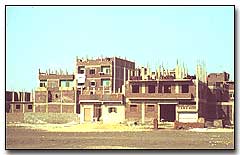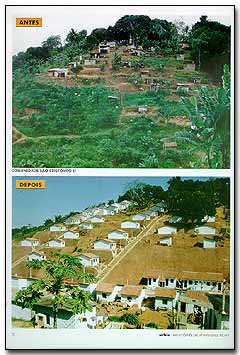|
|||||||||||||
|
|
|||||||||||||
|
|
|||||||||||||
Why not tear down slums and build new?By tearing down houses you also tear down social networks. These social links help people to cope with a difficult situation, and offer a sense of identity and belonging. Moreover from an economic standpoint, experience shows that new development can cost between 10-15 times more! And finding land is becoming increasing difficult for new low-cost developments and often outright impossible. But fundamentally, why tear down houses when already there is a huge need for sheltering families - in essence you would be increasing the problem and making things worse. First choice by far is to upgrade what you have. |
|||||||||||||

New Delhi, India. Strong social ties
San Crieouvo, Brazil. A successful project. |
Why does relocation not work?Relocation does not work because adequate open land at prices affordable to the public sector cannot be found at suitable locations for the low-income residents who will occupy it. They are too far from employment areas (especially the casual employment on which many depend). In some cases, pocket infill sites can be found close to the slum areas, where those can be relocated who are in the rights-of-way of essential infrastructure. Where is the evidence that in-place slum upgrading is the best course of action?Excellent examples can be seen in Pakistan, Sri Lanka, Indonesia, the Philippines and in several countries in Latin America. Isn't it better to invest more in economic development?Realistically we must do both economic promotion as well as upgrading. We must create jobs for communities! But studies have shown that for every $1 invested in upgrading of infrastructure, an additional $7 of housing investment was mobilized from non-project sources. In effect, upgrading has mobilized additional energies and funds beyond the narrow scope of a project. Upgrading indirectly supports economic development through improved health. We just cannot wait for economic development and institution-building to take hold, we must do something now. |
||||||||||||
|
|||||||||||||

Lusaka, Zambia. Pride of place. |

Cairo, Egypt. Homes in all stages of development. |
||||||||||||
|
|||||||||||||
|
|||||||||||||

